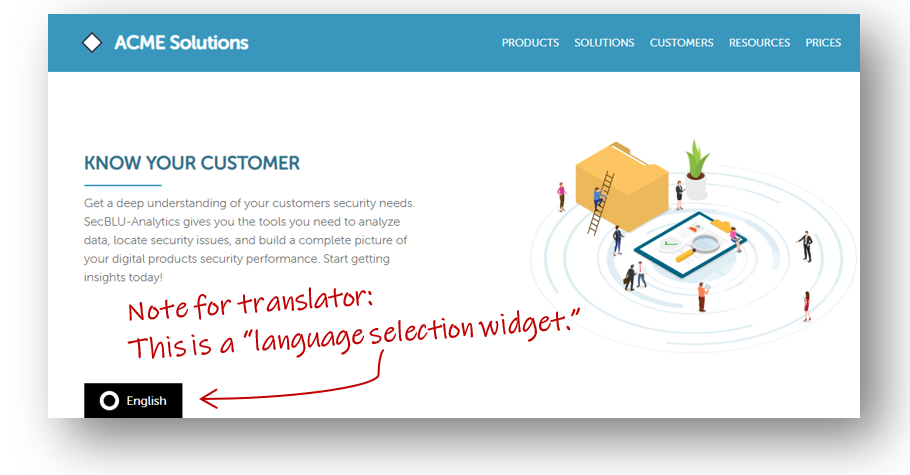As technology makes the world more interconnected, companies all over the globe are going international. There’s an emerging mindset that a company can be born global and reach out to international markets from day one.
Although eager businesses might be tempted to jump headfirst into the worldwide market, it’s wise to take things slowly and concentrate on maintaining quality in your localization campaigns.
The first step in localization is a quality translation of your content. When working with your translators, it’s necessary to pay extra attention to translation context.
What is Translation Context?
A translator must understand your text before they can translate it. Providing your translators with as much contextual information as possible will help to greatly improve the quality of your translations.
Why is context so important? Because the translation of any word from English into a foreign language can vary greatly. The way the word is translated can depend on several factors – subject matter, gender, case, and whether the source word is a noun, verb, or adjective. Situational context is also a factor that determines how words work differently in different situations, times of day, or regions.
As an example, let’s look at the word “turn” in a variety of contexts.
- Making a left turn.
- A turn of the page.
- Your turn in a card game.
- The turn of the year or the century.
- A turn of events.
- Taking a turn for the worse.
- A record turnout at an event.
- The weather turning to snow.
- That turned out to be a bad fit.
The list could go on! It’s unlikely that a single translation of the word “turn” in another language will cover all of these contexts. So it’s best to leave plenty of clues for your translators to help them understand your meaning. We call these clues translation context.
Tips for Excellent Translation Context
Here are some ways to help your translators produce the best possible translation of your content.
Sharing Textual Context
To improve the quality of translations, it’s essential to leave context notes for your translators so they can understand the context of any tricky words, phrases or slang. Missing context can dramatically increase the chances of errors in your content.
Sometimes, you may need to make your content. more localization-friendly. Consider modifying your English source text to avoid confusing words for translators. For example, a sentence like “You might run into an error if you click the Exit button” could be translated literally, like “You might jog into an error if you click the Exit button.” Instead, you can increase clarity with a better phrase with clear context: “Do not click the Exit button.”
Sharing Visual Context
Another way to provide better translation context is with visuals. Visual context can help translators understand the meaning of your source language.
-
- Screenshots
Provide a screenshot of a word or phrase that makes your context clearer for the translator. - Images and Diagrams with Notes
Another way to provide context is to use an image or diagram to clearly show your translator what you’re describing. For complex products with industry-specific jargon, providing diagrams or illustrations can help your translators understand your context and avoid translation errors. For instance, here’s an example from the Localize website.

- Screenshots
Ensuring Good Translation Quality
Localization plays an essential role in the pursuit of new global business. Quality control should be a foundational step in the localization process, rather than an afterthought when things have gone wrong.
Make Context a Part of Your Translation Workflow
Any translation project requires a high level of linguistic expertise. Your translator needs to be familiar with the local dialect and culture of the target audience. Incorporating context into all phases of the translation process will help to ensure a top-quality end product.
Here are some tips for ensuring you get the best translation for your international audience.
-
- Choose Dependable Translators
A good language service provider (LSP) can expertly handle your translation and localization projects. One benefit of working with an LSP is that you can reduce your overhead costs related to the hiring of in-house localization specialists in a variety of different languages. - Remote Testing
Before launching your product or service in a new country, you should run a test to find out how your prospective customers will perceive your content. With the latest technology, it’s possible to conduct remote testing from devices in the targeted country. Thorough testing helps you gain perspective on how your content appeals to the culture of the target audience. - Conduct Frequent Content Reviews
However good your translators are, it can be difficult to get your content 100% right on the first attempt. You should always check the target text for quality before you publish a translation. Over time, your company branding and terminology may also change, which means your content will need to be updated. Review your translated content frequently to keep it current and error-free. - Choose a Reliable Translation Tool (TMS)
As your localization efforts grow, it’s important to have the right TMS. Features like glossaries, terminology lists, and translation memory help you keep translations organized and accurate. TMS platforms like Localize also make it easy to send context notes to your translators.
- Choose Dependable Translators
Let Localize Help You With Translation Context
Localize’s state-of-the-art TMS comes with tools to streamline the process of assigning context to your translations. Before translations go live, Localize makes collaboration easy with a built-in quality check. Plus, a variety of translation methods can be seamlessly integrated into our platform.
To learn how we can help your localization team translate websites, mobile apps, or docs, give us a call.







